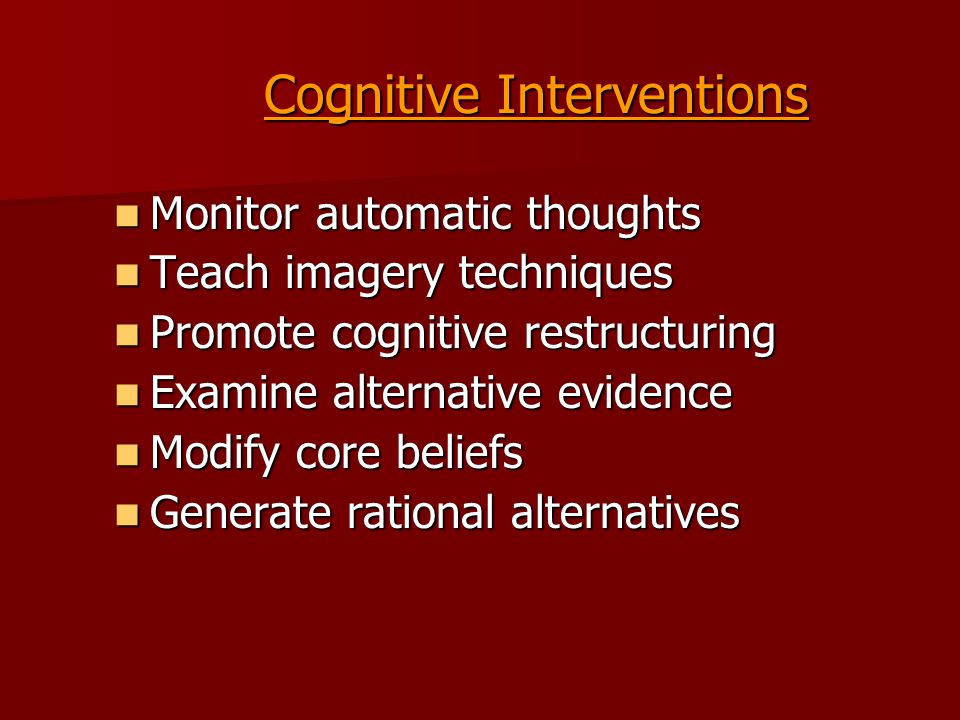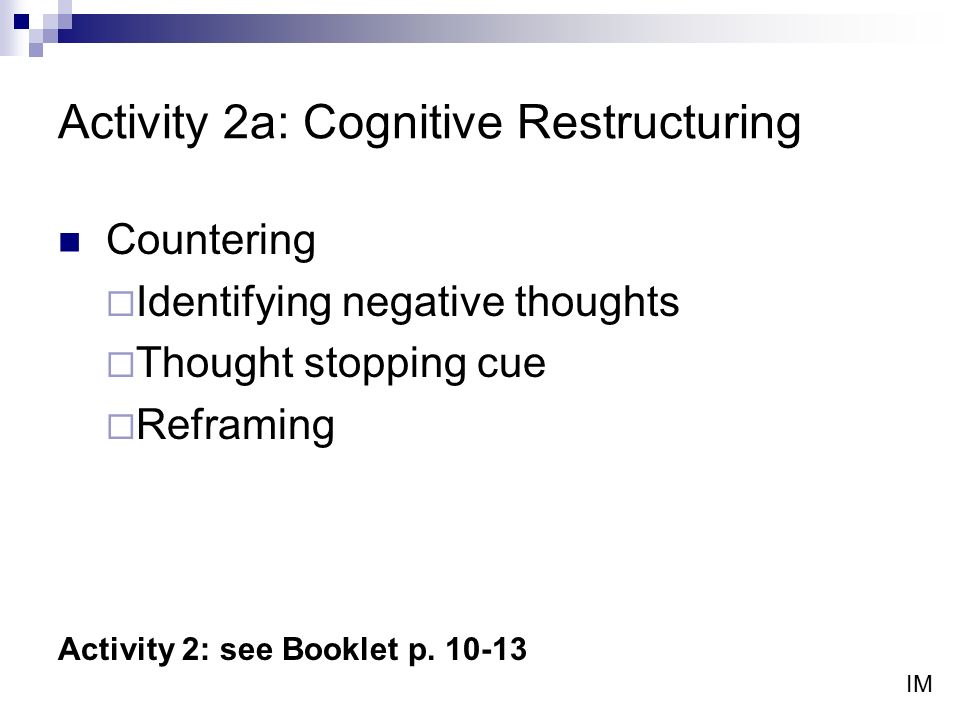-
Gallery of Images:

-
Cognitive Restructuring Of Core Beliefs Automatic Thoughts. Positive automatic thoughts can offset the negative effects of both negative automatic thoughts and stress in general. For example, people with high levels of positive automatic thoughts are likely to respond to stress by feeling that their lives are more meaningful, while people with low levels of positive automatic thoughts are. What is Comprehensive Cognitive Behavioral Therapy? How is Comprehensive CBT used to Overcome Social Anxiety Disorder? It wasnt long ago that very few people had heard the term cognitive behavioral therapy. Selfmonitoring of thoughts, feelings, and symptoms is an essential skill in cognitive behavioural therapy (CBT). This Simple Thought Monitoring Record is an excellent introduction to the process of collecting (negative) automatic thoughts, emotions, and the situations in which they are experienced. Cognitive therapy (CT) is a type of psychotherapy developed by American psychiatrist Aaron T. CT is one of the therapeutic approaches within the larger group of cognitive behavioral therapies (CBT) and was first expounded by Beck in the 1960s. Cognitive therapy is based on the cognitive model, which states that thoughts, feelings and behavior are all connected, and that individuals can. Sorensen, Sandra Larios, in EvidenceBased Addiction Treatment, 2009. Cognitive behavioral approaches are based on the theory that learning processes play a formative role in the development and maintenance of addictive behaviors. BEHAVIORIrURAPY20, , 1989 Cognitive Behavior Therapy for Negative Body Image JAMES C. ROSEN ELAYNE SALTZBERG DEBRA SREBNIK Umverstty of Vermont Subjects weretwentythree normal weight womenwith disturbedbody image, but without eating disorders, who were randomly assigned to either cogmtive behavior therapy or mmimal treatment. Danny Gagnon PhD, Psychologist (514) 3 Now lets test you! Here is another example for you to complete. Introduction to Common Psychotherapy Approaches: CognitiveBehavioral Therapy and Shortterm Psychodynamic Therapy described similarities and differnces between the two approaches and the differences in empasis for individuals in psychological treatment. From the Articles and Archives of Clinical Psychology Associates of North Central Florida, Gainesville Florida. Origins of the two approaches Psychologist Aaron Beck developed cognitive therapy in the 1960s. The treatment is based on the principle that maladaptive behavior (ineffective, selfdefeating behavior) is triggered by inappropriate or irrational thinking patterns, called automatic thoughts. Predicting adolescents' intentions to drink alcohol: Outcome expectancies and selfefficacy. CognitiveBehavioral Therapy is a form of psychotherapy that emphasizes the important role of thinking in how we feel and what we do. Definition of Cognitive Behavioral Therapy The Evolution of Cognitive Psychology The Evolution of Cognitive Psychology Definition of Cognition Cognition is the mental process or faculty of acquiring knowledge by the use of. Here's a list of 25 cognitive behavioral therapy techniques, CBT interventions, exercises and tools. Try the workbook in your own CBT practice. List of CBT techniques (Cognitive behavioral therapy techniques): Journaling or in some way keeping a record of your moods andor thoughts, especially noting the time, the extent of the mood or thought, and what led to it. This is the data gathering phase. This journaling process is sometimes referred to as a thought record and belongs at the top of any list of CBT techniques. Cognitive Behavioral Therapy Brief history of the theory and theorist. In it's simplest form, Cognitive Behavioral Therapy, (or CBT as it will be referred to from here on out), refers to the approach of changing dysfunctional behaviors and thoughts to realistic and healthy ones. Cognitive restructuring (CR) is a psychotherapeutic process of learning to identify and dispute irrational or maladaptive thoughts known as cognitive distortions, such as allornothing thinking (splitting), magical thinking, overgeneralization, magnification, and emotional reasoning, which are commonly associated with many mental health disorders. CR employs many strategies, such as Socratic. The biological Explanation of Nicotine Addiction Desensitization Hypothesis (Dani Heinemann 1996) By now youll be familiar with neurochemicals such as dopamine and serotonin and have a good understanding of how these act on a synapse. Cognitive behaviour therapy (CBT) is widely reported as being as effective as medication to treat depression and anxiety (Better Health Channel 2016). LEARNING STRATEGIES, TEACHING STRATEGIES. AND NEW CURRICULAR DEMANDS: A CRITICAL VIEW Perspectives, a Journal of TESOLItaly, Vol. 2, Fall 2002 Warning: Negative thinking can cause severe health problems and, in extreme cases, death. While cognitive restructuring has been shown to have a positive effect on reducing occasional negative thinking, they are for guidance only, and readers should take the advice of suitably qualified health professionals if they have any concerns over related illnesses or if negative thoughts are causing. This Cognitive Behavioural Therapy Practitioner course will allow students to become an Achology qualified CBT Practitioner and creates an opportunity to learn one of today's most established and respected professions. The course will enable practitioners in training to apply indepth knowledge of. CognitiveBehavioral Therapy (CBT) is the fastestgrowing psychotherapy in the world today, largely because it has been clinicallytested and found effective for a broad range of psychiatric and psychological problems. Cognitive therapy is a generic term that refers to diverse cognitive approaches to modifying human experiences and activities. This critique focuses on cognitive therapy that focuses on altering. Belzer is research fellow and Dr. Liebowitz is director of the Anxiety Disorders Clinic at New York State Psychiatric Institute in New York City. McKee is clinical assistant professor of psychology in psychiatry at the Weill Medical College of Cornell University and research scientist at the Anxiety Disorders Clinic at the New York State Psychiatric Institute in New York City. This authoritative book reviews current cognitivebehavioral models of OCD and delineates an innovative, theoretically and empirically grounded approach to assessment and treatment..
-
Related Images:











